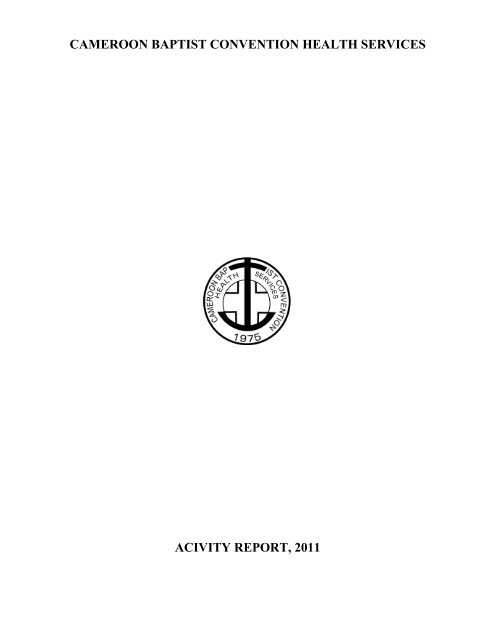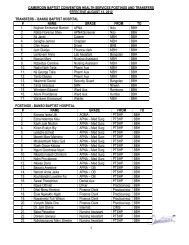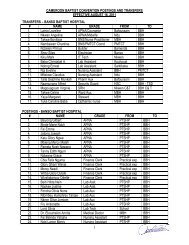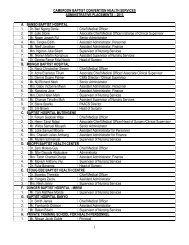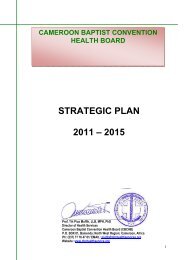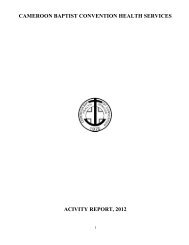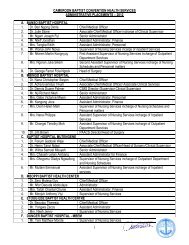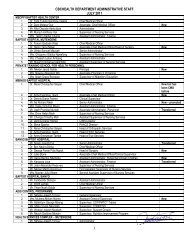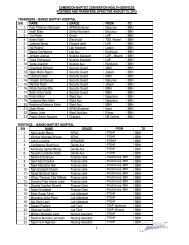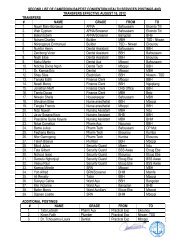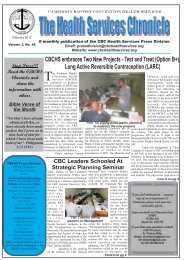2011 Annual report - Cameroon Baptist Convention Health Services
2011 Annual report - Cameroon Baptist Convention Health Services
2011 Annual report - Cameroon Baptist Convention Health Services
Create successful ePaper yourself
Turn your PDF publications into a flip-book with our unique Google optimized e-Paper software.
CAMEROON BAPTIST CONVENTION HEALTH SERVICES<br />
ACIVITY REPORT, <strong>2011</strong>
CAMEROON BAPTIST CONVENTION HEALTH SERVICES<br />
ANNUAL REPORT, <strong>2011</strong><br />
__________________________________<br />
Prof. Tih Pius Muffih, LLB, MPH, PhD<br />
Director of <strong>Health</strong> <strong>Services</strong><br />
<strong>Cameroon</strong> <strong>Baptist</strong> <strong>Convention</strong> <strong>Health</strong> Board (CBCHB)<br />
P.O. BOX 01, Bamenda; North West Region; <strong>Cameroon</strong>, Africa<br />
Ph: (237) 77 76 47 81/ EMAIL: piutih@cbchealthservices.org<br />
Website: www.cbchealthservice.org
TABLE OF CONTENT<br />
Mission Statement ................................................................................................................... 6<br />
Acknowledgement ................................................................................................................... 6<br />
A. NARRATIVE REPORT ..................................................................................................... 7<br />
1.1.1.Introduction ..................................................................................................................... 7<br />
1.1.2.Private Training School for <strong>Health</strong> Personnel (PTSHP), Banso ..................................... 7<br />
1.1.3.Life Abundant Primary <strong>Health</strong> Care (LAP) .................................................................... 8<br />
1.1.4.Technical <strong>Services</strong> Department (TSD) ........................................................................... 9<br />
1.1.5.Chaplaincy <strong>Services</strong> ........................................................................................................ 9<br />
1.1.6.AIDS CARE AND PREVENTION SERVICES ......................................................... 10<br />
1.1.7.Socio-Economic Empowerment of Persons with Disabilities (SEEPD) Program ........ 12<br />
1.1.8.Background ................................................................................................................... 12<br />
1.1.9.CENTRAL PHARMACY (CP) .................................................................................... 14<br />
1.1.10.<strong>Health</strong> <strong>Services</strong> Complex (HSC) ................................................................................ 16<br />
1.1.11.Banso <strong>Baptist</strong> Hospital (BBH) .................................................................................... 16<br />
1.1.12.Mbingo <strong>Baptist</strong> Hospital (MBH) ................................................................................ 17<br />
1.1.13.<strong>Baptist</strong> Hospital Mutengene (BHM) .......................................................................... 19<br />
Table 1: Summary of performance of CBCHB institutions in <strong>2011</strong> .................................... 22<br />
Table 2.1 – Bed Distribution by Hospitals and <strong>Health</strong> Centers ............................................. 23<br />
Table 2.2 Number of Beds distributed by ward, comparing 2010 and <strong>2011</strong> ......................... 23<br />
Table 3.1 Staff strength by institution and cadre ................................................................... 24<br />
Table 3.2 staff strength by cadre comparing 2010 and <strong>2011</strong> ................................................. 24<br />
Table 4.1: Outpatient Attendance ......................................................................................... 24<br />
Table 4.2 – Outpatient distribution by gender ...................................................................... 25<br />
Table 5.2 Five <strong>Health</strong> Centers with lowest OPD attendance in 2010 and <strong>2011</strong> .................... 26<br />
Table 6.1 – Admissions by institutions and by wards .......................................................... 26<br />
Table 6.2 Admissions of <strong>2011</strong> compared to 2010 ................................................................. 26<br />
Table 6.3 Bed occupancy rate of <strong>2011</strong> compared to 2010 ..................................................... 27<br />
Table 6.3 Bed occupancy rate by Institution ......................................................................... 27<br />
Table 7 – Patients flow per department for <strong>2011</strong> compared to 2010 ..................................... 27<br />
Table 8: Departmental Patient Flow for Hospitals and IHCs ............................................... 28<br />
Table 9.1: Mother and Child <strong>Health</strong> (MCH) FOR <strong>2011</strong> COMPARED TO 2010 ................. 28<br />
Table 9.2: Deliveries for <strong>2011</strong> compared to 2010 ................................................................. 28<br />
Table 10: Immunization for 2010 compared with 2009 ....................................................... 29<br />
Fig 2 ....................................................................................................................................... 29<br />
................................................................................................................................................ 29<br />
Table 12: Surgeries by Institution .......................................................................................... 30<br />
Table 13: Notifiable Diseases ............................................................................................... 30<br />
There was cholera outbreak in <strong>Cameroon</strong>. Many institutions received and treated cases,<br />
hence the increase in the <strong>2011</strong> figure. .................................................................................... 30<br />
Table 14: HIV Prevalence ..................................................................................................... 31<br />
Table 15: Deaths ................................................................................................................... 31<br />
Table 16 – 10 Leading Diseases for 2010 and <strong>2011</strong> .............................................................. 31<br />
Malaria continues to top the list of the leading diseases. Hypertension displaced upper and<br />
lower respiratory tract infections from the second to the six position. Diabetes mellitus,<br />
dermatitis and decubitus ulcers joined the list of leading diseases. ....................................... 31<br />
Table 17 – 10 leading causes of death ................................................................................... 32
Table 20: CBCHB PMTCT ACTIVITIES FOR 2010 AND <strong>2011</strong> ........................................ 33<br />
Table 21: CBCHS Tuberculosis activities ............................................................................ 34<br />
Annex 1- Five Year Evolution of Number of Beds and Staff ................................................ 34<br />
Annex 2 – Five Years Evolution of Outpatient Attendance .................................................. 35
LIST OF ABBREVIATIONS<br />
AB<br />
ANC<br />
BBA<br />
BBH<br />
BHM<br />
CBCHS<br />
CHF<br />
LRTI<br />
MBH<br />
NEOD<br />
OPD<br />
FP<br />
SB<br />
URTI<br />
UTI<br />
COC<br />
Abortion<br />
Antenatal Clinic<br />
Birth Before Arrival<br />
Banso <strong>Baptist</strong> Hospital<br />
<strong>Baptist</strong> Hospital Mutengene<br />
<strong>Cameroon</strong> <strong>Baptist</strong> <strong>Convention</strong> <strong>Health</strong> <strong>Services</strong><br />
Congestive Heart Failure<br />
Lower Respiratory Tract Infection<br />
Mbingo <strong>Baptist</strong> Hospital<br />
Neonatal Delivery<br />
Out Patient Department<br />
Family Planning<br />
Still Birth<br />
Upper Respiratory Tract Infection<br />
Urinary Tract Infection<br />
Chief of Center
Mission Statement<br />
The <strong>Cameroon</strong> <strong>Baptist</strong> <strong>Convention</strong> <strong>Health</strong> Department seeks to assist in the provision of care to all who<br />
need it as an expression of Christian love and as a means of witness in order that they might be brought to<br />
God through Jesus Christ. Thus, the <strong>Health</strong> Board seeks to provide exemplary health care with genuine<br />
compassion and with overriding purpose of evangelical witness.<br />
Vision<br />
Quality care to all<br />
Acknowledgement<br />
The accomplishments presented in this <strong>report</strong> are God’s Mighty blessing to our health care system<br />
through our collaborative efforts with our patients, partners and friends who have supported us in prayers,<br />
material and financial resources. Special appreciations go to the HMIS team, Heads of service, and all<br />
CBCHS staff who worked together to accomplish these results.
A. NARRATIVE REPORT<br />
1.1.1. Introduction<br />
The <strong>Cameroon</strong> <strong>Baptist</strong> <strong>Convention</strong> <strong>Health</strong> <strong>Services</strong> (CBCHS), a non-profit, faith-based healthcare<br />
organization has continued to strive in the provision of quality, affordable and accessible services to<br />
everyone who need them. The 6 hospitals, 24 Integrated <strong>Health</strong> Centers and 50 functional Primary <strong>Health</strong><br />
centers of CBCHS are distributed in six of the ten regions of <strong>Cameroon</strong>. The CBCHS provides holistic<br />
health services including preventive, curative and rehabilitative care. Special services and programs<br />
include the AIDS Care and Prevention Program, Central Pharmacy, Private Training School for <strong>Health</strong><br />
Personnel, Life Abundant Primary <strong>Health</strong> Care, Technical service department, <strong>Health</strong> Care technology<br />
unit, Chaplaincy services, Residency programs and <strong>Services</strong> for People with Disabilities<br />
1.1.2. Private Training School for <strong>Health</strong> Personnel (PTSHP), Banso<br />
The PTSFHP had major changes and accomplishments in <strong>2011</strong>. Leadership in the school changed hands<br />
and the school was reorganized creating eight departments offering a total of twenty programs.<br />
Mr. Nkwan Jacob was appointed as the Director of PTSFHP and Mrs. Ngwayu Margaret the Associate<br />
Director.<br />
The school graduated a total of one hundred and seventy (170) students; 25 Advanced Practice Nursing<br />
Assistants, 10 Laboratory Assistants, 4 Physiotherapy Assistants, 29 Nursing Assistants, 16 laboratory<br />
auxiliaries, 39 pharmacy auxiliaries, and 46 ward auxiliaries.<br />
Five Ophthalmic Medical Assistants (OMA) and eleven Assistant Ophthalmic Medical Assistants<br />
(AMOA) students are in second year of their course. The AOMA students will be completing in August<br />
2012, while OMA will be completing in August 2013.<br />
The following eight classes with a total enrolment of 205 started classes in <strong>2011</strong><br />
1. Advance Practice Nursing Assistant –Medical/Surgical (APNA-MS) with 33 students<br />
2. Advance Practice Nursing Assistant-Obstetric (APNA-OB) with 18 students<br />
3. Nursing Assistant with 56 students<br />
4. Nursing Auxiliary with 34 students<br />
5. Nurse Anesthetic with 8 students<br />
6. Physiotherapy Assistant with 10 students<br />
7. x-ray/Ultrasound Assistant Technician with 17 students<br />
8. Dental Auxiliary with 14 students
Twenty eight students were recruited to the Pharmacy Auxiliary course planned to start on January 09,<br />
2012. About seven candidates already in service will join them. Alongside trainings, the school was<br />
involved in the orientation of 40 newly recruited nurses and 12 Laboratory staff<br />
The school needs more staff and space, especially with the plan to commence the training of midwives<br />
and SRN in 2012. The school is appreciative of the support they are given by CBCHS administration.<br />
1.1.3. Life Abundant Primary <strong>Health</strong> Care (LAP)<br />
Through God’s guidance and Leadership LAP realized much in <strong>2011</strong> as highlighted; A total of 33,848<br />
consultations and 1,032 deliveries were conducted in the 50 functional primary healthcare posts.<br />
Several trainings we conducted including the training of 9 Community Mother Child <strong>Health</strong> Aides<br />
(CoMCHAs) in MCH Service delivery from 8 Villages at Ndu in March <strong>2011</strong> and training of 14 <strong>Health</strong><br />
Promoters from 10 villages in Promoter Basic Training from September to October <strong>2011</strong>. A refresher<br />
course in basic management skills was conducted for 30 Village <strong>Health</strong> Committee members drawn from<br />
10 communities. Nine LAP Field supervisors, 6 Primary <strong>Health</strong> Care Nurses and 6 Administrative staff<br />
participated in a bi-annual Resource Pool meeting in April and November <strong>2011</strong> to plan, monitor and<br />
evaluate the implementation of LAP project in the Field.<br />
Activities realized with the communities included the conduct of a baseline survey and Community<br />
Determined <strong>Health</strong> Care exercises in Bitui and Bougam LAP Villages to determine the demographic and<br />
health data of the two communities. LAP also carried out prospection in the following 8 Villages:<br />
Mbanga in the Littoral, Koba in the south West, Koutaba in the West, Balikumbat, Djottin, Soubum,<br />
Mbuyi and Mbokam in the North West. Amongst the 8 villages in prospection, Koba and Mbanga will go<br />
functional in December <strong>2011</strong> and January 2012. Currently, LAP is supervising 50 functional PHCs.<br />
Infrastructure wise, the Nwanti PHC building project was completed and it is functional. A nurse is<br />
recommended to be stationed there to fully utilize the facility. Bafia PHC building has been roofed.<br />
Two new PMTCT sites were created in the Vekovi and Mbengueji communities giving us 36 active<br />
PMTCT sites in LAP. The acceptance rate for the PMTCT program by clients has remained high at the<br />
rate of 96 %.<br />
Over 800 people listened to the counseling lecture for VCT in the Mbaw plain,564 clients were<br />
screened;44 were seropositive and 36 eligible for Care and treatment and are currently on Anti-Retroviral<br />
Therapy(ART)
LAP was blessed with several visiting missionaries from NAB and BGC this year. They are Sister Dapne<br />
Dunger, founder of LAP, Sister Myrna Goodman and Dr Edwards and his wife. The LAP family is very<br />
appreciative of the support they continue to receive from these partners like BftW, NAB, BGC, etc.<br />
The LAP family organized A Praise and Thanksgiving service in honour of Sister Daphne Dunger and<br />
Myrna Goodman during their visit to LAP on the 15 th of May <strong>2011</strong>.This service was geared towards<br />
raising funds for a Prayer Retreat Centre.<br />
LAP has produced a documentary titled “The Hope of the Grassroots People of <strong>Cameroon</strong>” which<br />
highlights the History of LAP since its inception in 1980.<br />
Through the LAP spiritual activities that are ongoing, over 5000 people were ministered to with the<br />
gospel of Salvation and 30 people rededicated their lives to Christ. Mr. Berinyuiy Christopher is the first<br />
staff in LAP to complete the 33 Theological Education by Extension (TEE) courses and was awarded a<br />
Certificate of Theology during the Nso Field annual Bible conference that held at Mbanso in November<br />
<strong>2011</strong>.<br />
1.1.4. Technical <strong>Services</strong> Department (TSD)<br />
Technical <strong>Services</strong> Department undertook twenty four projects this year. Some were completed while<br />
others are in progress. The level of realization of the department depends on cash flow. In all, over 60%<br />
of the planned projects was accomplished.<br />
1.1.5. Chaplaincy <strong>Services</strong><br />
The Chaplaincy and Social <strong>Services</strong> staff worked hard in <strong>2011</strong> and accomplished the following;<br />
Staff and patients daily devotions were regular, and helped in renewing the strength of workers and<br />
patients. Weekly Bible study ran throughout all our institutions. Although TEE was not regular in some<br />
institutions, three staff completed the thirty two courses of TEE. Lord supper services were conducted in<br />
some main institutions and this enriched the lives of some patients and caregivers. The Gospel teams and<br />
choir groups have been very instrumental in the outreach ministries.<br />
The social workers continued with the assessment of cases, handling some and referring others.<br />
The spiritual emphasis of this year went well, with guest speakers drawn from local churches. It ended<br />
with staff going out to some churches to pray with them. Some churches gave them maximum<br />
cooperation by even sending their support to the benevolent fund.
The chaplains and social workers’ association meeting held according to plan. Presentations were made<br />
on personal financial planning, music, foundational beliefs, etc.<br />
The difficulties encountered include the high cost of the text books for the TEE course that is limiting<br />
enrolment, some stations do not have ordained chaplains and consequently lord super service is not a<br />
common practice, the lack of Bibles to present to people that are witnessed to and they express the need<br />
and some churches do not coorporate in observing the HD prayer Sunday.<br />
1.1.6. AIDS CARE AND PREVENTION SERVICES<br />
The CBCHB AIDS Care and Prevention Program CBCHS-ACP made much progress in <strong>2011</strong> in<br />
her efforts of HIV Prevention, Care and Treatment and Psychosocial Support. Funding from<br />
EGPAF, the major CBCHS funding source began declining and fortunately, CBCHS was<br />
successfully in establishing new partnerships. This <strong>report</strong> highlights the accomplishments of<br />
various prongs of ACP. The PMTCT program was expanded to 16 new sites in <strong>2011</strong> leading to a total<br />
of 451 functional sites at. The program counseled and tested a total of 101275 clients, 5559 (5.6%) of<br />
whom were HIV positive. Trainings and refresher courses were conducted on PMTCT and proposal<br />
writing. The PMTCT coordinators worked in collaboration with the districts in conducting supervision at<br />
the sites.<br />
Main challenges encountered during the year included the slow implement the new World <strong>Health</strong><br />
Organization (WHO) guidelines due to insufficient drugs and limited follow up of HIV positive mothers<br />
and their HEIs.<br />
The Orphan Care (Chosen Children) Program provided assistance to 980 of the 3000 children registered<br />
children. Of the 980; 48 children are living with HIV. Assistance was mainly in school needs and medical<br />
bills coverage for those that needed it. Limited food subsidy was provided to some family following<br />
assessment and recommendation from field agent. The Field Agents continued to visit and families to<br />
provide necessary psychosocial support to the families. The program joined the rest of the world on May<br />
7, <strong>2011</strong> in celebrating the world AIDS orphan day. Activities carried out were aimed at raising awareness<br />
on the plight of orphans and soliciting support. A total of six hundred and fifty thousand francs<br />
(650,000frs) was raised. The difficulties experienced in limited funding, refusal of some family members<br />
to stay with HIV infected Orphans, working with old caregivers (grandparents), etc.<br />
The CBCHS care and treatment staff worked hard in <strong>2011</strong>, enrolling 2,316 new clients in the 5 CBCHS<br />
Care and Treatment sites, bringing the cumulative enrollment over time to 15,526. At the end of <strong>2011</strong>,<br />
there were 1,240 clients on ART. The CBCHS Care and Treatment held two joint coordination<br />
meetings with CBCHS TB staff. The meetings were characterized by clinical / case
presentations on HIV and TB, presentations on monitoring and evaluation, financial matters<br />
and other managerial issues. A service improvement committee meeting of CBCHB care and<br />
treatment was held, with the main goal being to ensure that the services provided by C&T<br />
continue to meet standards. Biannual supervisory visits were made to all sites. Infrastructure<br />
wise, Nkwen Care and Treatment Clinic was renovated and construction work at Etoug-Ebe<br />
<strong>Baptist</strong> <strong>Health</strong> Centre started. A four wheel drive hilux bought for BBH care and treatment<br />
centre was put to use. The main difficulties that were encountered included the long<br />
interruption in CD4 reagents supply chain and the limited and inadequate supply of ARV<br />
drugs.<br />
The CBCHS TB program screened a total of 6,767 clients in <strong>2011</strong>. There was 50% co-infection<br />
in the 1,062 TB cases that were identified. The program staff worked hard to ensure all<br />
identified patients adhere to treatment and completed it.<br />
The Youth Network for <strong>Health</strong> continued to educate youths the importance of abstinence. A<br />
total of number 45,963 young people were educated and sensitized on HIV and AIDS this year.<br />
Training was provided to ten peer educators to work with youths in clubs. Three workshops<br />
were conducted with a total of 205 parents on empowering them to provide sex education at<br />
home. Voluntary counseling and testing was organized for 1,317 youths and 23 of them were<br />
HIV positive. The program prepared and submitted an abstract to ICASA which was accepted<br />
for oral presentation. The Program Supervisor attended this international meeting at Addis<br />
Ababa and made the presented which was well received. The main setback of the program is<br />
limited funding.<br />
The Women’s <strong>Health</strong> Program organized a grand launching of the second phase of the Gardasil Project<br />
that was presided over by the Honorable Minister of Public <strong>Health</strong>, H.E Andre Mama Fouda at the<br />
Gynaeco –Obstetric and Pediatric Hospital Yaounde. The program organized a one week family Planning<br />
Training for community. Using funds from the CORDAIDS aware, a 30 minutes video of program<br />
documentary was produced. The program staff participated in national and international training<br />
programs in Nigeria, Ethopia and Yaounde. Three coordination meetings were organized this year. WHP<br />
was blessed with many visitors who support the work. These include Drs. Thomas and Edie Welty; who<br />
provided moral and technical support, Dr. Richard Sims, a volunteer consultant<br />
Obstetrician/Gynaecologist from Canada; who carried out interventions to a total of 30 patients with<br />
invasive cervical cancers, Ms. Leah Marsh, a premedical student in the USA and finally, Dr. Maria<br />
Moore, a US based Medical Oncologist. The program still spent a lot on custom charges despite the<br />
exemption that was expected. The main challenge of WHP include the fact that a Local News Paper; “Le
Soir” Wrote an article to scandalize the Gardasil Project. This made some parents to refuse their girl<br />
children from taking the vaccine, creating a break in the number of doses they are to take. This is<br />
reflective in the feedback from the Gynaeco-Obstetric and Pediatric Hospital in Yaounde, that succeeded<br />
to vaccinate just two hundred (200) out of the two thousand four hundred (2400) girls they agreed to<br />
vaccinate. This has left the program with doses for more than two thousand (2000) girls to be vaccinated<br />
within few months. Meanwhile, the program has long completed its own portion of vaccinating 2400 girls<br />
of the 2 nd phase.<br />
The nutrition improvement program (NIP) staff worked hard accomplishing the following in <strong>2011</strong>;<br />
• Provided NIP services at 26 CBCHS PMTCT sites including 5 LAP Primary <strong>Health</strong> Centers.<br />
• Developed monitoring and evaluation tools.<br />
• Organized training for 26 participants from West and Adamawa regions from 26 different health<br />
facilities (Gov’t, CBCHB, Catholic & private) on nutrition and infant feeding counseling in<br />
Bafoussam.<br />
• Recruited and trained seven staff who were posted to five health units to function as nutrition and<br />
infant feeding counsellors.<br />
• Held one coordination meeting and one committee meeting.<br />
1.1.7. Socio-Economic Empowerment of Persons with Disabilities (SEEPD) Program<br />
1.1.8. Background<br />
The Socio-Economic Empowerment of Persons with Disabilities Program is a 3 year initiative (2009-<br />
<strong>2011</strong>) designed to break the vicious cycle of poverty and disabilities through socio-economically<br />
empowering persons with disabilities in the North West Region of <strong>Cameroon</strong>. The Program came to an<br />
end in December <strong>2011</strong>. In <strong>2011</strong>, the Program continued to implement activities in its five domains of<br />
intervention which are medical and rehabilitation services, education of children with disabilities,<br />
economic empowerment, research and communication. The summary <strong>report</strong> below presents the<br />
Program’s progress towards its overall objective.<br />
7.2 Medical and Rehabilitation services<br />
The medical and rehabilitation component of the Program was designed to lead to an increase in the scope<br />
and utilization of medical and rehabilitation services. In <strong>2011</strong>, the following results were achieved:<br />
1. The number of medical and rehabilitation services meeting the needs of persons with impairment<br />
increased to eleven with the introduction of Low Vision Service in the Banso <strong>Baptist</strong> Hospital.<br />
Low Vision services provide vision rehabilitation either through the use of devices or through<br />
training. A total of 26 children were identified with low vision and have been enabled to use<br />
devices to improve on their vision and learning in schools. During the year, the Community<br />
Based Rehabiliation Program was re-organized to increase coverage of seven divisions of the<br />
Region with Mbingo and Banso as the bases.
2. With a target of 38,000 for <strong>2011</strong>, the number of people attending medical and rehabilitation<br />
services reached 38,558. Of this number, 2,310 benefited from eye, orthopedic and ENT<br />
surgeries.<br />
3. A total of 8,876 people benefited from services provided to them in their communities through<br />
outreaches.<br />
7.3 Education<br />
The purpose of the education component was to increase the participation and success of children<br />
with disabilities in education. In <strong>2011</strong>, the Program continued using the twin-track approach- one<br />
being special education and the other inclusive education, leading to the attainment of the following<br />
results;<br />
1. A total of 64 primary and secondary schools were sensitized on improving access to school in<br />
order to facilitate access for pupils and students with disabilities. The Higher Teachers’ Training<br />
College Bambili has shown significant interest in introducing inclusive education as a module in<br />
the institution. The SEEPD Program shall start providing training to student teachers of that<br />
college on Inclusive Education during the second semester. This is the first effort in <strong>Cameroon</strong><br />
for inclusive education to be introduced in a higher education institution. The Jakiri Council<br />
under the leadership of the Mayor has participated in the identification of children with<br />
disabilities in its municipality. The Council provided scholarships to all those with hearing<br />
impairments from the municipality enrolled in the School for the Deaf in Mbingo.<br />
2. The number of parents of children with disabilities counseled on the importance of education for<br />
their children increased by 451.<br />
3. Children with disabilities in mainstream schools have experienced improvement in their<br />
performances resulting from the ongoing training and monitoring of teachers in 14 primary and<br />
secondary schools on inclusive education. Government Bilingual High School Ntamulung<br />
Bamenda has enrolled the first student with a visual impairment in the institution.<br />
7.4 Economic Empowerment<br />
The economic empowerment component focuses on ensuring that more persons with disabilities are<br />
successfully integrated in the local economy. <strong>2011</strong> actions led to 2 main accomplishments:<br />
1. Communities created more economic opportunities for persons with disabilities. Through<br />
Program advocacy, 22 persons with disabilities gained employment. With training on<br />
assertiveness, 33 persons with disabilities took up leadership positions in their communities.
2. More persons with disabilities made use of economic empowerment opportunities in<br />
communities. 291 persons with disabilities attended training on business management. 150<br />
women with disabilities successfully enrolled in women’s development groups in communities.<br />
7.5 Research<br />
The prevalence of disabilities in the North West Region has been estimated at 6.9% resulting from the<br />
pilot study started in 2009 and completed in July <strong>2011</strong>. This information will facilitate planning and<br />
decision making for the Program, government and other stakeholders on designing and implementing<br />
future programs for persons with disabilities in the Region.<br />
7.6 Communication<br />
The communication component seeks to increase the effect of mainstream campaigns on the quality of<br />
life of persons with disabilities.<br />
1. A total of 2,748 words were taught to 326 families of persons with hearing impairments in 198<br />
communities. This has improved communication between family members and persons with<br />
hearing impairments.<br />
2. A total of 21,664 persons listened to talks on HIV/AIDS, malaria and TB. Of this number 4,160<br />
were persons with disabilities.<br />
3. Monthly information on topical issues was distributed to persons with disabilities in adapted<br />
formats.<br />
The program has greatly impacted the lives of persons with disabilities in the Region. The level of<br />
awareness on the need to mainstream disability in development efforts is increasing. Persons with<br />
disabilities are gaining esteem and moving away from charity to participating in development. The<br />
Program has progressed in three years towards its overall objective of socially and economically<br />
empowering persons with disabilities as a way of breaking the vicious cycle between poverty and<br />
disability. The CBC <strong>Health</strong> <strong>Services</strong> is grateful to her partners for their commitment to ensuring that<br />
persons with disabilities experience improvements in their quality of life.<br />
1.1.9. CENTRAL PHARMACY (CP)<br />
CP activities were generally low key and many of our targets were not met. The department is working on<br />
a scheme that will guarantee that orders are placed and paid in a timely manner so as to minimize the outof-stock<br />
situation and thus meet our primary objective. The summary accomplishments of the CP<br />
departments are as follow;<br />
The main objective of the Drug Supply <strong>Services</strong> of making available quality products accessible all the<br />
time was far from being met. Many drugs ran out of stock following delays in orders which often are a
esult of delayed payment of previous orders. Also, the prices of a lot of commodities have increased in<br />
the world market, leading to increased prices of drugs, the latter of which tend to go higher when payment<br />
is delayed. Plans for improving upon storage space in Mutengene and Banso could not be executed. Drug<br />
transportation with the single large truck has been difficult particularly to places like Banso.<br />
Besides regular production, the Chemical Production Company developed a new product which is in the<br />
test phase to be introduced into the product line. Trusting that all goes well, the CP bathing soap, “His<br />
Grace”, will become available soon. There were difficulties in acquiring some raw materials which are<br />
now strongly restricted in international traffic. Plans for purchasing a soap cutting table and metallic soap<br />
forms to improve the aesthetics of the products, and remodeling of the production area could not be<br />
realized. Tanks have been bought for dissolving and diluting bleach.<br />
The non-sterile Production Company activities have equally been very low key for the most part of this<br />
year due to the lack of raw materials. This resulted in out of stock for most of the non-sterile products in<br />
the health facilities. The main challenge of the department is that virtually all of the work is done<br />
manually.<br />
The Sterile Production Company met only about 15% of the target for the production of IV infusion fluids<br />
due to machine break down. Eye drop production was however consistent. The company is preparing to<br />
receive and install a new distiller.<br />
HESCO Water Production Company activities are gradually picking up. The spares of the filling machine<br />
were received, fitted, test runs carried out, and the filling machines have proven themselves reliable.<br />
Labels and cap sleeves had been ordered and for now, a significant quantity of water has been sent to our<br />
institutions. Some needed raw materials like pre-forms and caps, cap-sleeves and labels have been<br />
ordered and the manufacturers have completed production of the items ordered. The shipping of reforms<br />
and caps is still to be effected due to the pending balance payment.<br />
The main activities of the quality assurance unit this year have been drugs and water quality controls.<br />
Over 100 different drugs procured within and out of <strong>Cameroon</strong> were controlled. In the last quarter of<br />
<strong>2011</strong>, an environmental unit was created within quality assurance unit following the advice of the<br />
Ministry of Environment and Nature Protection. A staff was recruited to lead in this aspect. Central<br />
Pharmacy is still working with a Quality System and Process Consultant to assist it in attaining ISO 9001<br />
quality standards.
1.1.10. <strong>Health</strong> <strong>Services</strong> Complex (HSC)<br />
The <strong>Health</strong> <strong>Services</strong> Complex, Mutengene accomplished over 80% of her planned maintenance activities<br />
for <strong>2011</strong>. The quality and capacity of the HSC Rest house have improved significantly. Three new selfcontained<br />
rooms were added to the rest house and 10 new beds acquired. Air conditions and wireless<br />
internet connection were installed in all the rest houses.<br />
There are functional committees that follow through the implementation of everyday activities of the<br />
station. The committees include: the Spiritual Life Committee, Catering committee, Sports Committee,<br />
HIV and AIDS Committee and Farm Committee. The women also have a Women’s committee which<br />
aims at preserving the female values and mentoring young women. These committees have facilitated the<br />
work of the management and financial committees. In fact, the needs of the institutions are easily<br />
identified and addressed.<br />
The security of all HSC property, staff and clients has been greatly enhanced by the completion of metal<br />
doors and windows and the existence of security dogs and contract with G4S. Plans are underway to<br />
strengthen the concrete fence to complete the planned security strategy. Court hearing for the armed<br />
robbery attack that took place on October 19, 2009 is still going on in the high court in Buea.<br />
The process of establishing a land title for the portion of the land purchased from Chief Luma is still in<br />
progress.<br />
In addition to the challenge involved in the process of acquiring a land title for the land purchased, HSC<br />
current main problem has been the absence of an intercom system.<br />
1.1.11. Banso <strong>Baptist</strong> Hospital (BBH)<br />
The staff of BBH worked devotedly in <strong>2011</strong>, serving a total of 92,810 outpatients and 8,092 inpatients.<br />
Although the situation of doctors was very dynamic during the year, there was an overall improvement.<br />
The following events occurred in <strong>2011</strong>;<br />
Five permanent and five substitute staff representatives were elected in April <strong>2011</strong>. Thirty nine employees<br />
of BBH and her Supervised <strong>Health</strong> Centre were happy recipients of 3 Labour Medals of honour (silver,<br />
Silver Gilt, and Gold medals) each on May 1, <strong>2011</strong>. The installation of the appointed Leaders of BBH<br />
took place on September 9, <strong>2011</strong>. New in the team were Mr. Ngam Joseph who took over as Senior<br />
Administrator and Pastor Bambo Denis who joined as Assistant Administrator, Personnel.<br />
Work on the outpatient building slowed down because funding ran low. It was estimated that the project<br />
needs 60 million francs to be completed and put to use. This will be budgeted for in 2012.
The finishing of the ground floor of the Eye department building was completed and eye service<br />
provision commenced in the building in April <strong>2011</strong>. With the suspension of HIPC funding, work was<br />
halted on the PTSHP building project after the decking of the 3 rd floor.<br />
The work was completed on the Dunger <strong>Baptist</strong> Hospital Solar system and the system is functioning well.<br />
A water tank is being mounted at Bangolan <strong>Baptist</strong> <strong>Health</strong> Center. The Centre and the community are<br />
pursuing the connection of AES to the <strong>Health</strong> Centre. The Ngounso <strong>Baptist</strong> <strong>Health</strong> Center maternity<br />
building project is being completed. The center is very busy and would need a resident doctor. The<br />
Chief Romkong <strong>Baptist</strong> <strong>Health</strong> Center resigned on March 31, <strong>2011</strong> and a new Chief of Center was<br />
appointed. There were no major events in the rest of the BBH supervised health centers.<br />
1.1.12. Mbingo <strong>Baptist</strong> Hospital (MBH)<br />
With a total work force of 571 and a bed capacity of 270, MBH served a total of 8,913 inpatients and a<br />
total outpatient of 72,660. MBH continued to supervise ten integrated health centers and other preventive<br />
and rehabilitative services including, the community based rehabilitation, integrated school for the deaf,<br />
eye outreach, etc. Other than Sabga <strong>Baptist</strong> <strong>Health</strong> Center, all the Mbingo supervised integrated health<br />
centers were financially self-sustaining. In <strong>2011</strong>, MBH accomplished the following activities;<br />
Several changes occurred in the leadership positions of the hospital. The new leaders are;<br />
Chief Medical Officer<br />
Dr. Nana Christopher<br />
Associate Chief Medical Officer/Clinical Supervisor Dr. Acha Evaristus<br />
Clinical Supervisor<br />
Dr. Dennis Palmer<br />
Assistant Administrator of Personnel<br />
Mrs. Gabe Victorine<br />
Assistant Administrator of Finance<br />
Mr. Kangong Joce<br />
Senior Administrator<br />
Mr. Nji Richard Nkeh<br />
The new leaders were installed on August 26, <strong>2011</strong>.<br />
Obstetric/Gynecological (Ob/Gyn) services are now fully provided to the clients. This is made possible by<br />
the return of Dr Tebid Ignatius from training in Tanzania. Similarly, eye care services which slowed<br />
down due to the departure of Dr Wryter and Dr. Tambe became fully functional with the return of Dr.<br />
Tebid Marvice and Dr. Tambe from training at Tanzania and India respectively. With the presences of Dr.<br />
Rich Barden (internist/pathologist), the laboratory services have been upgraded both in equipment and<br />
services offered. An automatic hematology analyzer (URIT-3300) recently acquired has greatly reduced<br />
patients waiting time.<br />
MBH has continued to host and support several training programs. Courses that are ongoing or<br />
commenced in <strong>2011</strong>are;
1. The Pan African Academy of Christian Surgeons (PAACS) with 9 residents and Christian Internal<br />
Medicine Specialization (CIMS) program with 5 residents. The number of intake of PAACS residents<br />
has been increased from 2 to 3.<br />
2. A one year nurse practitioner training program with an enrolment of four, with one of the students<br />
from Catholic Hospital Njinikom.<br />
3. A three year nurse anesthetist training program with an enrollment of 8 students. Dr. Keith<br />
Streatfeild is the main trainer.<br />
4. The Assistant Ophthalmic Medical Assistants (AOMA) and the Ophthalmic Medical Assistants<br />
(OMA) with 11 and 5 students enrolled respectively.<br />
5. The supervision of doctors on internship by Dr. Dennis Palmer with four doctors under his<br />
supervision at the end of the year.<br />
Other short term courses including the screeners’ course, training of clerical staff, training of Ward<br />
auxiliary staff, etc were run at MBH<br />
The following key events took place in <strong>2011</strong>;<br />
1. Four leprosy patients were discharged and two vocational rehabilitation trainees graduated during the<br />
World Leprosy Day celebration at Mbingo <strong>Baptist</strong> Hospital on January 30 th , <strong>2011</strong>.<br />
2. Treatment Grant Application for free cleft surgery was completed on November 10 th , <strong>2011</strong> by<br />
Mbingo <strong>Baptist</strong> Hospital and submitted to Smile Train. A total of 70 cleft surgeries were conducted.<br />
3. MBH was officially approved as a College of Surgery of East, Central, and Southern Africa<br />
(COSECSA) surgery training site.<br />
4. Dr. Jayme MacKercher, a long term career physical therapist missionary arrived Mbingo <strong>Baptist</strong><br />
Hospital on May 16 th , <strong>2011</strong> to replace Sr. Pat Lenz.<br />
5. An ultrasound machine and two defibrillators were donated by two donors from Australia to the<br />
hospital. The sum of 150,000 francs to assist patients living with HIV and AIDS was donated by<br />
MBH Doctors/administrators’ wives and female doctors social group of MBH to the hospital. Several<br />
church groups and individuals visited Mbingo and donated gifts (food and clothes) to Hansen disease<br />
patients and the deaf children.<br />
6. The Minister of Public <strong>Health</strong>, His Excellency Andre Mama Fouda visited Nkwen <strong>Baptist</strong> <strong>Health</strong><br />
Centre on March 10 th , <strong>2011</strong><br />
Infrastructure wise, two low cost duplex, a fourplex, one doctors’ resident and a patients’ overflow houses<br />
were completed and put to use. The foundation of the Bafoussam <strong>Baptist</strong> <strong>Health</strong> Centre and the outpatient<br />
building project in Sabga were completed. Work continued slowly on the ground floor of the OPD project<br />
due to financial constraints. Space is urgently needed for the ENT, Ob/Gyn and the HIV/TB Care and<br />
Treatment services. The ITECH Team (hydro engineers/electricians) from USA carried out a two week
feasibility study on the construction and installation of a hydroelectric plant at Mbingo <strong>Baptist</strong> Hospital<br />
and estimated the cost at 900 million francs. Funds are being raised for this project while an application<br />
has been submitted to the Minister of Energy and Water for his approval.<br />
Despite the aforementioned accomplishments, some major challenges that were experienced included,<br />
staff shortage and inadequate beds in some wards. MBH has many ambitious goals for 2012 but plans to<br />
focus on orthopedic ward and outpatients projects first.<br />
1.1.13. <strong>Baptist</strong> Hospital Mutengene (BHM)<br />
The staff of BHM worked hard in <strong>2011</strong>, serving the increasing workload of 93,252 outpatients and 3,377<br />
inpatients. The following major events occurred during the year;<br />
- Two female doctors joined the team.<br />
- BHM structures were re-painted giving the compound a new look<br />
- An OOKVA generator was purchased and installed. It is functioning well<br />
- Seventeen workers were awarded labour medals of honour<br />
- The <strong>Health</strong> board central administration bought a land cruiser vehicle for the hospital<br />
- The maternity delivered and successfully managed 52 premature babies<br />
- Work on the maternity project progressed steadily and was roofed on the 6 th September <strong>2011</strong>. Tiles<br />
have been put on the floor of the basement. The outside wall of the first floor has been constructed<br />
and pillars are being planted for the ramp.<br />
The major challenges that BHM is facing include the urgent need for a building – to host the TB isolation<br />
ward<br />
Work is in progress on the first floor of the Kumba <strong>Baptist</strong> <strong>Health</strong> Center building. The first and second<br />
decking were done. The main goals of the center for 2012 are to roof the building and to construct the<br />
bridge to the center. The Centre purchased a slit lamp machine for the eye department.<br />
The Etoug-Ebe <strong>Baptist</strong> <strong>Health</strong> Center accomplished a lot in <strong>2011</strong>. The access road to the center was<br />
paved, bridges built and gutters constructed. Construction work on the care and treatment building is in<br />
progress. A visual field machine was purchased for the eye department.<br />
The payment for Ekounou <strong>Baptist</strong> <strong>Health</strong> Center land will be completed in 2012. The center bought a<br />
photocopy machine, a Hilux vehicle and a slit lamp for eye services this year.<br />
1.2. <strong>Baptist</strong> Hospital Banyo (BHB)
In <strong>2011</strong>, <strong>Baptist</strong> Hospital Banyo served 9,203 outpatients and 1,719 inpatients and effectively supervised<br />
her three affiliated <strong>Health</strong> Centers through bi-monthly support visits to each of them.<br />
Infrastructure wise, a caregiver’s kitchen was constructed and put to use. This was made possible by<br />
donations from Dr. James Smith’s sources and CBCHS. Some rooms of the building are used to host<br />
visitors and relief duty staff.<br />
The Ministry of Communication approved a CBC Radio Station, which is functional at Banyo, thanks to<br />
Dr. James Smith for his efforts in following through the process. The naming of the station will be<br />
carefully done to avoid confusion with that of Bamenda. This communication medium will facilitate the<br />
dissemination of health messages and other information to the Banyo community.<br />
In addition to the need for a more permanent doctor to work with Doctor Smith, the other major needs of<br />
BHB are a vehicle and a generator.<br />
10.6 Mboppi <strong>Baptist</strong> Hospital Douala<br />
The year <strong>2011</strong> was very busy, with an increasing patient load. A total of 210,359 outpatients were served<br />
and 2,835 deliveries conducted. The presence of the maternity services has led to an increase in the<br />
number of women attending the antenatal clinic.<br />
The eye department started an optical workshop. Eye glasses are being shaped and dispensed in the<br />
Centre. This service has greatly been appreciated by the patients. Patients do not have to wait for long<br />
before receiving their prescribed eye glasses.<br />
A canteen and provision shop services went operational this year. Patients and staff appreciate the food<br />
that is served at affordable prices. The center is striving to improve the standards of these services.<br />
Construction work is progressing on the second and third floors of the main building and has significantly<br />
progressed in the laundry building.<br />
Equipment bought for the hospital this year include a lenso meter, edging machine, cash machines, hot air<br />
oven for the laboratory, electrical stimulator for the physiotherapy, electro-surgical machine for the<br />
theatre, and a fetal monitor. The 2012 goals of the center include installing an intercom system,<br />
reinforcing the drainage system, constructing a biogas system, purchasing a Hilux vehicle and dental<br />
chair<br />
B. HEALTH INFORMATION MANAGEMENT SYSTEMS (HMIS)
The HMIS team worked hard to continue to improve on the quality of data that is <strong>report</strong>ed. HMIS training<br />
was conducted for 37 HMIS staff drawn from all CBCHS institutions on September 19-21, <strong>2011</strong> at <strong>Health</strong><br />
<strong>Services</strong> complex Mutengene. The goal of the training was to enhance understanding of the <strong>report</strong>ing<br />
indicators of staff who compile statistics and to ensure that all CBCHB institutions have trained staff<br />
responsible for statistical <strong>report</strong>ing.<br />
The statistics presented in this <strong>report</strong> compare <strong>2011</strong> activities with those of 2010. Generally, service<br />
utilization increased in <strong>2011</strong>. Overall, CBCHS institutions served 860,844 clients on outpatient basis and<br />
42,861 inpatients. Contributing factors to this increase in uptake include expansion, the quality of services<br />
provided, and affordability.
Table 1: Summary of performance of CBCHB institutions in <strong>2011</strong><br />
INDICATOR/DEPARTMENT<br />
Bed Capacity<br />
Staff Strength*<br />
OPD attendance<br />
Inpatient Attendance<br />
Deliveries<br />
Major Surgeries<br />
Minor Surgeries<br />
Deaths<br />
Patients served by<br />
Pharmacy<br />
Patients served by<br />
Laboratory<br />
Patients served by Doctors<br />
Patients served by<br />
Screeners<br />
Eye Department<br />
Chaplaincy<br />
Social Worker<br />
Dental Department<br />
Ultrasound Department<br />
Physiotherapy Department<br />
X - Ray Department<br />
BBH MBH BHM MBHD BHB DBH SUPERVISED<br />
IHCs<br />
2 2<br />
4<br />
38 70 50 50 33 40 54<br />
5 5 1 1<br />
8<br />
19 71 89 88 47 22 01<br />
92,8 72,6 93,2 210,3 9,2 4,3 378,1<br />
10 60 52 59 03 69 91<br />
8,0 8,9 3,3 2,8 1,7 8 17,1<br />
92<br />
1,3<br />
27<br />
1,7<br />
44<br />
4,0<br />
00<br />
5<br />
28<br />
72,9<br />
40<br />
45,3<br />
58<br />
16,2<br />
89<br />
26,3<br />
21<br />
10,9<br />
58<br />
4,6<br />
84<br />
2,9<br />
22<br />
7,9<br />
93<br />
5,6<br />
54<br />
5,5<br />
71<br />
4,3<br />
03<br />
13<br />
8<br />
01<br />
3,7<br />
36<br />
6,4<br />
05<br />
5<br />
48<br />
59,1<br />
52<br />
44,6<br />
58<br />
37,4<br />
08<br />
35,2<br />
52<br />
11,6<br />
45<br />
5,1<br />
68<br />
2,5<br />
38<br />
1,8<br />
96<br />
8,8<br />
68<br />
7,4<br />
01<br />
8,5<br />
56<br />
77 35 19 06 19<br />
8 1,8 2 1<br />
3,5<br />
50 24 07 56 24<br />
5 3 2<br />
63 49 33 31 -<br />
1,3 3,6 3 1 20,0<br />
52 68 44 85 58<br />
1<br />
1<br />
14 7 42 3 23<br />
63,1 146,0 8,2 4,1 318,6<br />
05 09 56 71 91<br />
41,9 49,2 5,9 2,3 166,2<br />
45 81 06 98 68<br />
14,9 31,3 2,9 6 17,7<br />
72 89 27 03 84<br />
80,6 179,2 4,3 3,6 252,5<br />
63 14 83 79 85<br />
8,8 21,0 8<br />
32,6<br />
56 43 23 - 74<br />
2,0 1,6 8 5<br />
8,7<br />
70 63 19 22 12<br />
2,2 1,4<br />
39 03 - - -<br />
3,3 6,3<br />
22,1<br />
08 94 - - 79<br />
4,6 5,8 1,7<br />
2,1<br />
16 53 22 - 17<br />
2,6 5,6<br />
5,5<br />
79 14 - - 67<br />
1,5<br />
8<br />
65 - 23 - -<br />
Total<br />
1,1<br />
35<br />
2,3<br />
37<br />
860,8<br />
44<br />
42,8<br />
61<br />
8,6<br />
89<br />
6,6<br />
56<br />
36,0<br />
12<br />
1,3<br />
65<br />
672,3<br />
24<br />
355,8<br />
14<br />
121,3<br />
72<br />
582,0<br />
97<br />
85,9<br />
99<br />
23,6<br />
38<br />
9,1<br />
02<br />
41,7<br />
70<br />
28,8<br />
30<br />
26,8<br />
32<br />
15,2<br />
47<br />
*: Staff of supervised IHCs includes those of LAP, DHS OFFICE, HSC AND TSD
Table 2.1 – Bed Distribution by Hospitals and <strong>Health</strong> Centers<br />
Hospital Medical Maternity Pediatric Surgical Total %<br />
BBH 104 39 51 44 238 21<br />
MBH 161 22 26 61 270 23.8<br />
BHM 20 18 6 6 50 4.4<br />
MBHD 0 50 0 0 50 4.4<br />
BHB 16 3 7 7 33 2.9<br />
DBH 23 17 0 0 40 3.5<br />
Other Institutions 251 158 45 0 454 40<br />
Total 575 307 135 118 1135 100<br />
There are 1,129 1,135 beds in total in all CBCHS institutions at the end of <strong>2011</strong>.<br />
Table 2.2 Number of Beds distributed by ward, comparing 2010 and <strong>2011</strong><br />
S/N WARD 2010 <strong>2011</strong> % CHANGE<br />
1 Medical 564 575 2<br />
2 Maternity 303 307 1.3<br />
3 Pediatric 145 135 -6.9<br />
4 Surgical 117 118 0.9<br />
TOTAL 1129 1135 0.5<br />
The overall number of beds in CBCHS institutions increased by 0.5% in <strong>2011</strong>. The changes in the number<br />
of beds in the various wards is due to shifting of beds following patients’ trends. The number of beds in<br />
the medical and surgical wards was periodically increased with beds from other wards to accommodate<br />
the increased patients.
Table 3.1 Staff strength by institution and cadre<br />
SN GRADE BBH MBH BHM MBHD BHB DBH OTHERS TOTAL<br />
1 Doctors 13 26 6 8 2 0 2 57<br />
Trained<br />
2 Nurses<br />
139<br />
122 63 62 15 4 81 486<br />
3 Auxiliary 99 121 34 18 10 6 157 445<br />
4 Paramedical 65 36 36 27 7 1 77 249<br />
Administrator<br />
5 s<br />
3<br />
3 2 2 1 0 5 16<br />
6 Admin Staff 59 32 4 16 1 2 64 178<br />
7 Chaplains 13 7 6 4 1 1 12 44<br />
8 Others 129 224 82 42 13 16 356 862<br />
TOTAL 520 571 233 179 50 30 654 2337<br />
Table 3.2 staff strength by cadre comparing 2010 and <strong>2011</strong><br />
S/N CADRE 2010 <strong>2011</strong> % CHANGE<br />
1 Doctors 44 57 29.5<br />
2 Trained Nurses 477 486 1.9<br />
3 Auxiliary 400 445 11.3<br />
4 Paramedical 301 249 -17.3<br />
5 Administrators 22 22 0<br />
6 Administrative staff 192 178 -7.3<br />
7 Chaplains 42 44 4.8<br />
8 Others 746 856 14.7<br />
TOTAL 2224 2337 5.1<br />
Overall staff strength increased by 5.1% in <strong>2011</strong>. The changes in staff of various categories comes as a<br />
result of staff returning from school, recruitment, going to school, leaving for alternative employment,<br />
etc.<br />
Table 4.1: Outpatient Attendance<br />
SN INSTITUTION 2010 <strong>2011</strong> % CHANGE<br />
1 BBH 92,219 92,810 0.6<br />
2 MBH 73,126 72,660 -0.6<br />
3 BHM 84,180 93,252 10.8<br />
4 MBHD 177,175 210,359 18.7<br />
5 BHB 9,182 9,203 0.2<br />
6 DBH 4,569 4,369 -4.4<br />
7 Other Institutions (IHCs) 361,478 378,191 4.6<br />
TOTAL 801,929 860,844 7.3<br />
There was an overall increase of 7.3% in outpatient attendance in <strong>2011</strong> compared to 2010. Despite this<br />
increase, MBH and DBH observed a small reduction in outpatient attendance.
Table 4.2 – Outpatient distribution by gender<br />
SN GENDER 2010 <strong>2011</strong> % CHANGE<br />
1 Male 330,178 343,307 4<br />
2 Female 471,751 517,537 9.7<br />
TOTAL 801,929 860,844 7.3<br />
Generally, more females utilize services at CBCHB institutions than males. Women attended to in <strong>2011</strong><br />
increased by 4% while men increased by 9.7% relative to 2010.<br />
Figure 1<br />
The proportion of patients older than 15 that were served in <strong>2011</strong> increased while that of patients less than<br />
15 was similar in both years<br />
Table 5.1: Five <strong>Health</strong> centers with Highest OPD Attendance in 2010 and <strong>2011</strong> Mboppi is now a<br />
Hospital<br />
SN 2010 <strong>2011</strong><br />
<strong>Health</strong> Center Attendance <strong>Health</strong> Center Attendance<br />
1 MBOPPI 177,175 ETOUG-EBE 103,329<br />
2 ETOUG-EBE 92,984 NKWEN 71,540<br />
3 NKWEN 71,454 KUMBA 32,773<br />
4 KUMBA 35,654 EKOUNOU 28,915<br />
5 EKOUNOU 25,933 BAFOUSSAM 27,702
With the upgrading of Mboppi <strong>Baptist</strong> <strong>Health</strong> Center to a hospital, Etoug-Ebe <strong>Baptist</strong> <strong>Health</strong> Center now<br />
tops the list of <strong>Health</strong> center with highest outpatient attendance. This gave way for Bafoussam to<br />
resurface in the list of health centers with highest OPD attendance.<br />
Table 5.2 Five <strong>Health</strong> Centers with lowest OPD attendance in 2010 and <strong>2011</strong><br />
SN 2010 <strong>2011</strong><br />
<strong>Health</strong> Center Attendance <strong>Health</strong> Center Attendance<br />
1 AKEH 2,153 BAYANGAM 2,455<br />
2 NGEPTANG 2,893 AKEH 2,554<br />
3 SARKI BAKA 2,909 LASSIN 2,593<br />
4 LASSIN 3,241 ROMKONG 2,868<br />
5 ALLAT 3,320 SARKI BAKA 2,917<br />
Ngeptang and Allat dropped from the list of health centers with lowest OPD attendance while Bayangam<br />
and Romkong featured. Although Akeh, and Sarki Baka were retained in the list of centers with lowest<br />
OPD attendance, their patients’ attendance increased in <strong>2011</strong> compared to 2010.<br />
Table 6.1 – Admissions by institutions and by wards<br />
HOSPITAL MATERNITY PEDIATRIC SURGICAL MEDICAL TOTAL %<br />
BBH 1478 1520 1663 3431 8092 18.9<br />
MBH 925 853 2807 4328 8913 20.8<br />
BHM 967 706 563 1141 3377 7.9<br />
MBHD 1868 606 174 187 2835 6.6<br />
BHB 233 405 122 959 1719 4.0<br />
DBH 159 0 0 647 806 1.9<br />
IHCs 3887 3990 20 9222 17119 39.9<br />
TOTAL 9517 8080 5349 19915 42861 100<br />
Table 6.2 Admissions of <strong>2011</strong> compared to 2010<br />
SN UNIT 2010 <strong>2011</strong> % CHANGE<br />
1 Maternity 7,176 9,517 32.6<br />
2 Pediatric 7,153 8,080 13<br />
3 Surgical 4,645 5,349 15.2<br />
4 Medical 21,729 19,915 -8.3<br />
Total 40,703 42,861 5.3<br />
There was a 5.3% increase in the number of inpatients served in <strong>2011</strong>. More of the inpatients were in the<br />
maternity and surgical wards. The much increase in maternity clients was influenced by the uptake of<br />
services at Mboppi <strong>Baptist</strong> Hospital.
Table 6.3 Bed occupancy rate of <strong>2011</strong> compared to 2010<br />
SN INDICATOR 2010 <strong>2011</strong> % CHANGE<br />
1 Number of beds 1,129 1135 0.5<br />
2 Number of hospital days 197,446 197,973 0.3<br />
3 Average length of stay 4.9 4.6 (0.28)<br />
4 Bed occupancy rate 48.0 47.8 (0.20)<br />
5 Mortality rate 3.3 3.2 (0.12)<br />
There were minor decreases in average length of stay, bed occupancy rate and mortality rate.<br />
Table 6.3 Bed occupancy rate by Institution<br />
SN<br />
1<br />
2<br />
3<br />
4<br />
INDICATOR BBH MBH BHM MBHD BHB DBH Supervised<br />
IHCs Total<br />
Number of beds 238 270 50 50 33 40<br />
45 1,1<br />
4 35<br />
Number of admissions 8092 8913 3377 2835 1719 806<br />
17,11 42,8<br />
9 61<br />
Number of hospital days 55,749 75,612 13,525 8,444 6144 3806<br />
34,69 197,9<br />
3 73<br />
Average length of stay 6.9 8.5 4.0 3.0 3.6 4.7<br />
2 4.6<br />
5 Bed occupancy rate 64.2 76.7 74.1 46.3 51 26.1 20.9 47.8<br />
6 Deaths 528 548 114 7 42 3 123 1365<br />
7 Mortality rate 6.5 6.1 3.4 0.2 0.9 0.4 0.7 3.2<br />
Table 7 – Patients flow per department for <strong>2011</strong> compared to 2010<br />
SN DEPARTMENTS 2010 <strong>2011</strong> % CHANGE<br />
1 Eye 81,974 85,999 4.9<br />
2 X-Ray 14,946 15,247 2<br />
3 Physiotherapy 23,757 26,832 12.9<br />
4 Ultra-Sound 24,510 28,830 17.6<br />
5 Dental 38,784 41,770 7.7<br />
6 Laboratory 327,296 355,814 8.7<br />
7 Pharmacy 610,960 672,324 10<br />
8 Chaplaincy 19,684 23,638 20.1<br />
9 Patients seen by doctors 78,935 121,372 53.8<br />
10 Patients seen by screeners 574,952 582,097 1.2<br />
All departments served more patients in <strong>2011</strong>.
Table 8: Departmental Patient Flow for Hospitals and IHCs<br />
DEPARTMENT<br />
Eye<br />
X-ray<br />
Physiotherapy<br />
Ultra-sound<br />
Dental<br />
Laboratory<br />
Pharmacy<br />
Chaplaincy<br />
Patients seen by doctors<br />
Patients seen by<br />
screeners<br />
BBH MBH BHM MBHD DBH BHB IHCs<br />
10958 11645 8856 21043 0 474<br />
4303 8556 1565 0 0 823<br />
5571 7401 2679 5614 0 0<br />
5654 8868 4616 5853 0 1722<br />
7993 1896 3308 6394 0 0<br />
45358 44658 41945 49281 2398 5906<br />
72940 59152 63105 146009 4171 8256<br />
4684 5168 2070 1663 522 819<br />
16289 37408 14972 31389 603 2927<br />
1083 35252 80663 179214 3679 4383<br />
33,0<br />
23<br />
-<br />
5,5<br />
67<br />
2,1<br />
17<br />
22,1<br />
79<br />
166,2<br />
68<br />
318,6<br />
91<br />
657,3<br />
98<br />
17,7<br />
84<br />
270,6<br />
78<br />
TOTAL<br />
85,9<br />
99<br />
15,2<br />
47<br />
26,8<br />
32<br />
28,8<br />
30<br />
41,7<br />
70<br />
355,8<br />
14<br />
672,3<br />
24<br />
672,3<br />
24<br />
121,3<br />
72<br />
574,9<br />
52<br />
Table 9.1: Mother and Child <strong>Health</strong> (MCH) FOR <strong>2011</strong> COMPARED TO 2010<br />
ACTIVITY 2010 <strong>2011</strong> % CHANGE<br />
Antenatal Clinic 57,133 68,504 19.9<br />
Family Planning 36,907 44,398 16.9<br />
Infant Welfare Clinic 5,876 5,339 -10.1<br />
Preschool Clinic 4,472 6,105 36.5<br />
Table 9.2: Deliveries for <strong>2011</strong> compared to 2010<br />
DELIVERIES 2010 <strong>2011</strong> % CHANGE<br />
Total delivery 6,754 8,689 28.6<br />
Live birth 6,473 8,359 29.1<br />
Pre-term 204 195 -4.4<br />
Neonatal deaths 40 30 -25<br />
Births Before Arrival 76 61 -19.7<br />
Still Births 156 200 28.2<br />
Abortions 115 131 13.9<br />
Influence by uptake at MBHD, total deliveries increased by 28.6%. While undesired events like pre –<br />
term, Neonatal Deaths, and BBA decreased, still births and abortions increased. We shall study the causes<br />
of the increase in the number of still births.
Table 10: Immunization for 2010 compared with 2009<br />
SN VACCINE 2010 <strong>2011</strong> % CHANGE<br />
1 MENINGITIS 4,342 2,567 -40.9<br />
2 BCG 7,205 8,979 24.6<br />
3 DPT 19,618 22,992 17.2<br />
4 POLIO 26,663 31,573 18.4<br />
5 TITANUS 17,319 20,019 15.6<br />
6 MEASLES 5,781 5,823 0.7<br />
7 OTHERS 7,716 10,650 38<br />
Other than meningitis, all immunization activities increased in <strong>2011</strong>.<br />
Fig 2<br />
Table 11: Surgeries<br />
SN SURGERY 2010 <strong>2011</strong> % CHANGE<br />
1 MINOR 30,547 36,012 17.9<br />
2 MAJOR 5,559 6,656 19.7<br />
Total 36,106 42,668 18.2
There was an overall 18.2% increase in the number of minor and major surgeries put together in <strong>2011</strong><br />
compared to 2010.<br />
Table 12: Surgeries by Institution<br />
Surgery Type<br />
Institution<br />
Minor<br />
Major<br />
BBH<br />
4,000<br />
4<br />
MBH<br />
6,405<br />
6<br />
BHM<br />
1,352<br />
3<br />
MBHD<br />
3,668<br />
9<br />
BHB<br />
344<br />
3<br />
DBH<br />
185<br />
1<br />
Total<br />
1,74<br />
5744<br />
3,73<br />
10141<br />
56<br />
1915<br />
34<br />
4017<br />
23<br />
577<br />
3<br />
216<br />
Other Institutions 20,058 - 20058<br />
TOTAL 36,012 6,656 42,668<br />
Table 13: Notifiable Diseases<br />
DISEASES<br />
2010 <strong>2011</strong> % CHANGE<br />
Neonatal tetanus 15 3 -80<br />
Leprosy 11 12 9.1<br />
Yellow fever 4 2 -50<br />
Cerebrospinal meningitis 276 136 -50.7<br />
Human rabies 9 11 22.2<br />
Tuberculosis 1020 1089 6.8<br />
Cholera 5 81 1520<br />
Typhoid fever 410 302 -26.3<br />
Poliomyelitis 15 0 -100<br />
Measles 11 183 1563.6<br />
There was cholera outbreak in <strong>Cameroon</strong>. Many institutions received and treated cases, hence the<br />
increase in the <strong>2011</strong> figure.
Table 14: HIV Prevalence<br />
Type of Clients<br />
Blood donors<br />
Patients<br />
2010 <strong>2011</strong> %<br />
# Screened % HIV+ # Screened %HIV+ Change<br />
4<br />
,677<br />
3.8 4,421 2.0 -1.8<br />
3<br />
3,211<br />
21.8 34,841 18.6 -3.2<br />
HIV prevalence decreased among blood donors and hospital patients.<br />
Table 15: Deaths<br />
Wards 2010 <strong>2011</strong> % Change<br />
Pediatric 157 226 43.9<br />
Surgical 78 126 61.5<br />
Maternal 8 17 112.5<br />
Medical 1,108 996 -10.1<br />
TOTAL 1,351 1,365 1<br />
The number of deaths increased except medical deaths that dropped.<br />
Table 16 – 10 Leading Diseases for 2010 and <strong>2011</strong><br />
SN<br />
2010 <strong>2011</strong><br />
DISEASE CASES DISEASE CASES<br />
1 Malaria 62,336 Malaria 60,720<br />
2 URTI/LRTI 16,858 Hypertension 20,986<br />
3 Gastritis/PUD 10,959 Diabetes Mellitus 8,888<br />
4 Hypertension 10,904 Gastritis/PUD 8,472<br />
5 GE/Diarrhoea 7,633 Conjunctivitis 6,019<br />
6 Cystitis/UTI 7,005 URTI/LRTI 5,709<br />
7 Pityriasis 6,395 Cystitis/UTI 5,202<br />
8 Conjunctivitis 5,109 Dermatitis 4,250<br />
9 Ascariasis/other worms 4,997 Decubitus ulcers/wounds 4,125<br />
10 Myositis 4,506 GE/Diarrhea 3,914<br />
Malaria continues to top the list of the leading diseases. Hypertension displaced upper and lower<br />
respiratory tract infections from the second to the six position. Diabetes mellitus, dermatitis and<br />
decubitus ulcers joined the list of leading diseases.
Table 17 – 10 leading causes of death<br />
SN<br />
2010 <strong>2011</strong><br />
DISEASE CASES DISEASE CASES<br />
1 AIDS 229 AIDS 257<br />
2 Malaria 213 Malaria 191<br />
3 Road Traffic Accident 160 Pneumonia 69<br />
4 Tuberculosis 77 Congestive Heart Failure (CHF) 62<br />
5 Congestive Heart Failure 65 septicemia 42<br />
6 Hypertension 64 Anemia 42<br />
7 Sickle cell disease 58 Hepatitis/Cirrhosis 27<br />
8 Anemia 56 Cancers/ Tumors 27<br />
9 Septicemia 45 Diabetes Mellitus 26<br />
10 Renal Failure 25 Meningitis 25<br />
AIDS and malaria maintained the top position as the leading cause of death. Pneumonia, hepatitis,<br />
cancers/tumors, diabetes mellitus and meningitis were new in the list of ten leading causes of death.<br />
Table 18 – HIV Care and Treatment Program Work load<br />
SN<br />
1<br />
2<br />
3<br />
4<br />
5<br />
BBH<br />
MBH<br />
BHM<br />
NKWEN<br />
MBOPPI<br />
SITE<br />
TOTAL<br />
<strong>2011</strong> GENERAL<br />
ENROLMENT<br />
641<br />
246<br />
844<br />
646<br />
1,039<br />
<strong>2011</strong> ART<br />
INITIATION<br />
3,416 2,316<br />
CUMULATIVE ON<br />
ART<br />
CURRENT ON<br />
ART<br />
463 4,073 3,209<br />
169 1,287 779<br />
462 2,463 2,151<br />
526 4,227 3,425<br />
696 3,476 2,576<br />
There were 12,140 clients on ART at the end of <strong>2011</strong>. Of the 15,526 clients ever initiated on ART in the<br />
5,526<br />
five CBCHS care and treatment centres, others transferred out, some died while others were stopped.<br />
1<br />
140<br />
12,
Table 20: CBCHB PMTCT ACTIVITIES FOR 2010 AND <strong>2011</strong><br />
Indicator 2010 <strong>2011</strong><br />
# of Facilities 434 451<br />
# Counseled 102,307 101275<br />
# Tested 100,767 101275<br />
% Tested 98.5 100<br />
# Returning for results 100,505 98989<br />
% Returning for results 99.7 97.4<br />
# Positive 5,545 5559<br />
% Positive 5.5 5.6<br />
# of Mothers Receiving ARV prophylaxis 5,450 8124<br />
# of Infants Receiving ARV prophylaxis 3,705 3706<br />
% of Infants Receiving ARV prophylaxis 66.8 66.7<br />
Infants tested by PCR 1,791 1886<br />
Infants with positive PCR 178 334<br />
% HIV-Positive by PCR 9.9 17.7<br />
Comparing 2010 data with that of <strong>2011</strong>, there is a small decrease in the total number of women<br />
counseled, and tested. HIV prevalence rate among pregnant women is similar in both years.
Table 21: CBCHS Tuberculosis activities<br />
Indicators 2010 <strong>2011</strong> % CHANGE<br />
Total # of TB patients<br />
1,274<br />
1,290<br />
1.3<br />
Number screened for AFB<br />
6,180<br />
6,767<br />
9.5<br />
Number of pulmonary TB<br />
1122<br />
1,062<br />
-5.3<br />
Number of Smear Positive<br />
938<br />
878<br />
-6.4<br />
Number of Smear Negative<br />
177<br />
176<br />
-0.6<br />
Number of Extra Pulmonary TB<br />
154<br />
223<br />
44.8<br />
Number tested For HIV<br />
1194<br />
1,270<br />
6.4<br />
Acceptance rate<br />
93.7<br />
98<br />
5<br />
Number tested HIV+<br />
626<br />
636<br />
1.6<br />
% of Co-infection<br />
52.4<br />
50<br />
-4.4<br />
ANNEX – FIVE YEARS EVOLUTION OF CBCHS KEY ACTIVITIES<br />
Annex 1- Five Year Evolution of Number of Beds and Staff<br />
Not all health facilities have beds. There are many workers whose work has no direct<br />
relationship with beds, hence the high staff strength.
Annex 2 – Five Years Evolution of Outpatient Attendance<br />
.Annex 3- Five Years Evolution of Inpatients Attendance
Annex 4- Five Years Evolution of Department work load<br />
Annex 5- Patients seen in Laboratory and Pharmacy
Annex 6- Five Years Evolution of MCH Activities<br />
Challenges/ Way Forward<br />
Our treatment centers suffered from shortages of ARVs and TB drugs. This needs to be addressed at the<br />
national level in 2012. Drugs delayed either because we could not pay for them on time or because of<br />
failure to clear them at customs due to strict controls of all drug import by the ministry of health. We had<br />
limited work space in many institutions and this created congestion in our work. Staff housing, especially<br />
doctor housing posed major problems to us. We need more houses for our doctors. Many building<br />
projects which were started several years ago remained incomplete due to inadequate funds. Many<br />
patients who were given care could not pay their bills.<br />
We are thankful to God for the successes we recorded. The doors of all health facilities remained open to<br />
all patients throughout the year. All our staff worked happily delivering quality care to all with<br />
compassion. We enjoy the support of many national and international partners without which we could<br />
not have achieved all these results. We are very grateful.<br />
In conclusion, I wish to thank all our staff for their commitment to our mission statement as evident in our<br />
success. We are determined more than ever, to assist more patients recover their health and to helpf the<br />
entire population leave healthy lives in order to avoid illnesses.<br />
To God be the Glory.


